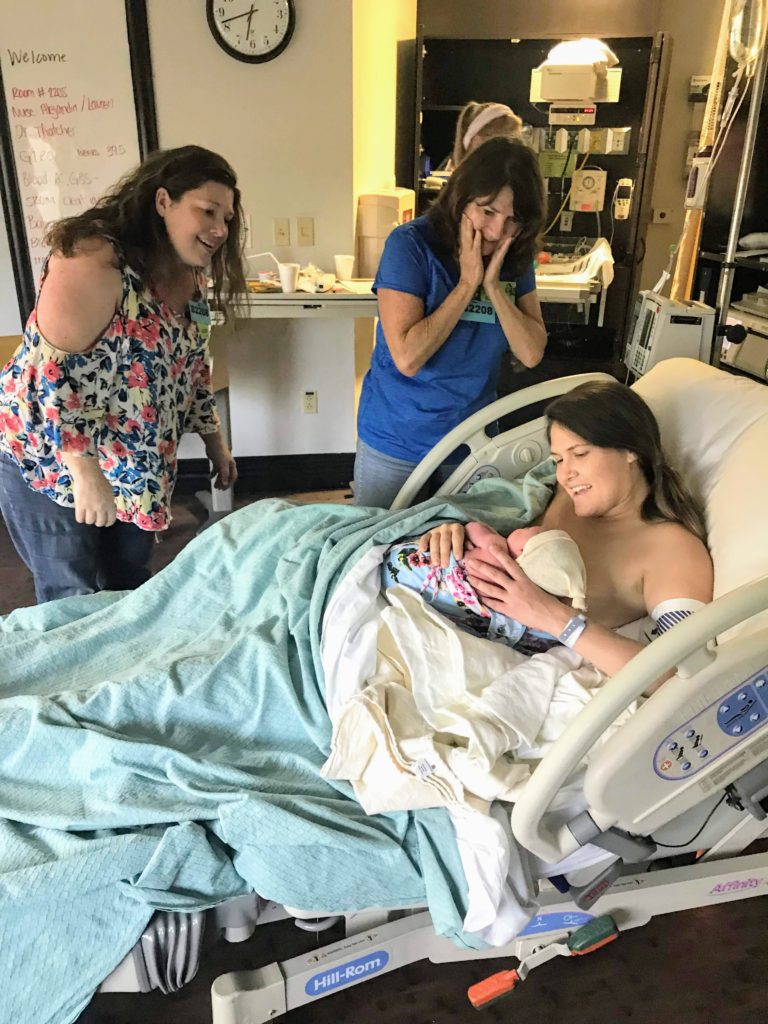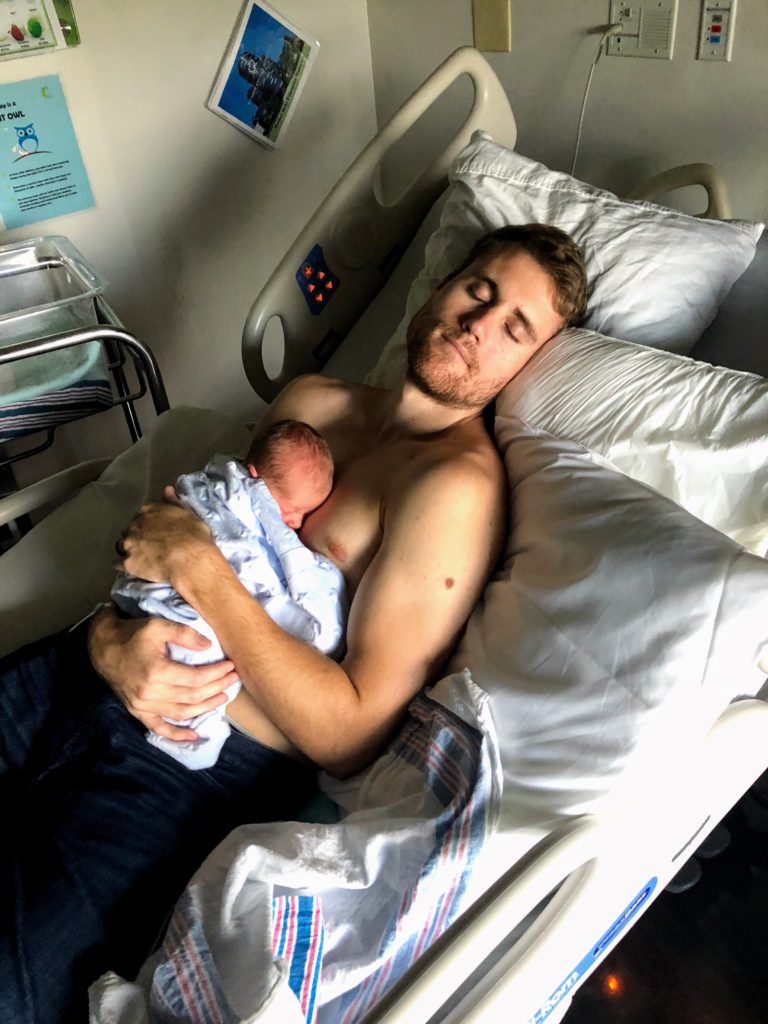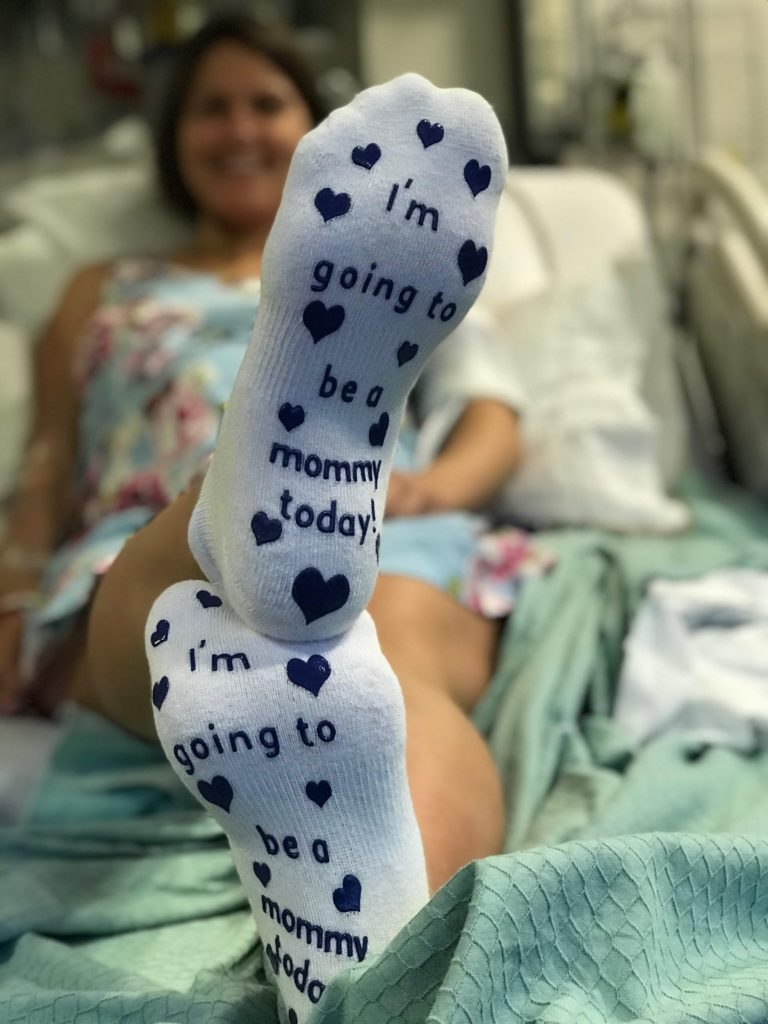Just when I thought my pregnancy may actually last forever, the beginning of the end arrived.
We had spent the day floating in the pool (which is unexplainably amazing when you are 39 weeks pregnant). At that point in pregnancy, each day was feeling even longer than the one before it. All I wanted was to hold my baby boy in my arms and have my mobility back.

When you are waiting for your delivery day, and especially as your due date approaches, everything feels like a sign that labor is about to happen.
Cramps stronger than usual? Better get the car ready. Feeling a little dizzy/tired/hungry/happy? Grab the hospital bag. So, on Saturday night, when I was peeing every 15 minutes, instead of the usual every hour, I did have a sneaking suspicion that labor might be around the corner.
Warning: This may be graphic for some. Read at your own risk.
Affiliate Disclaimer: I may earn a small commission if you choose to purchase any products or services from this website using my link. However, all of these opinions are my own and this article was written prior to me becoming an affiliate.
Water Breaking
At 3 a.m., I was suddenly jolted awake by a warm sensation in the bed. My water had broken. Unlike the movies, it wasn’t an opening of the floodgates, so I wasn’t even completely sure it happened. I woke up my husband up to which he sleepily replied, “What do you mean?” and “Are you sure?” before it really hit him that now was the time and he sprung out of bed.
As I got out of bed, more fluid began to flow out. No shame ladies, if you are pregnant and have not purchased adult diapers yet… treat yo self. In the event that your water breaks before labor, you will be so happy you bought them. Since I wasn’t in any pain yet (contractions hadn’t started), I was able to strap one of those bad boys on and move freely around the house without leaking everywhere.
Your water doesn’t usually just break and then stop, it can keep flowing until delivery.
We called our doctor and waited for instruction.
When the doctor had confirmed my water was broken, she instructed us to come straight to the hospital because the baby was no longer protected by the amniotic sac, and is susceptible to infection.
Hospital Bag
We grabbed our hospital bags, loaded up the car, and prepared for a long day ahead. After months of hospital bag preparation, “labor day” lists, and methodical planning, we still ran around like chickens with our heads cut off, trying to get everything we needed. Our adrenaline was through the roof.


Trip to Hospital
Thankfully, the traffic at 3:30 in the morning is pretty light.
When I had imagined this trip to the hospital for the birth, I had always thought I would have the perfect soundtrack playing, carefully selected for this very moment. As it turned out, U2 was the only thing loaded on my iTunes (thanks to the Apple mass U2 upload of 2014) so “Bar-Bar-Barbara, Santa Barbara Bar-Bar-Barbara, Santa Barbara” played in the background as we anxiously sped to Winnie Palmer.
Arriving at the Hospital
After being admitted to the hospital, I found out that I was only 2 cms dilated. The nurses asked how my contractions were feeling.
I had always been pretty confused about what a contraction actually felt like, but the best way I could describe my pain level was as menstrual cramps that were more on the aggressively painful side. Sidenote, if you’re lucky enough to have never experienced painful cramps during that time of the month and are wondering what they feel like, the next best comparison I can give is the ache in your side that running can sometimes bring on.
Anyway, they also wanted to know how often my contractions were happening. This was really hard for me to answer because I still wasn’t sure how to identify the feeling. Luckily, they hook you up to a Toco monitor that measures your contractions.
Later in the labor process, David and I found it very helpful to know how to read the Toco monitor , so that we could self-monitor when the nurses were not in the room. If you are preparing for child birth, I would recommend checking out the article I linked above.
Once the nurses had confirmed with a physical exam that my water had broken, I was told to change into a hospital gown and prepare to move to a birthing room. We would officially be staying until the baby was delivered.
Bringing your own labor gown
From prior research, I knew that I could bring my own gown to wear as long as it was just as accessible for the staff as the regular hospital gowns. Getting to change into something I felt good in, and was comfortable in, was huge for my mood. I would definitely suggest future mommies to find a hospital delivery gown you love.
Just make sure the gown you bring:
- Has an open-back of some kind (mine had buttons all down the back).
- Has an opening in the front or arms. My gown buttoned at the top of the tank top strap.
- Either opens in the front or is loose enough to place your baby, skin-to-skin, under your dress. My gown had enough space for Luke to lay on my chest under the gown.
My recommendation is the Baby Be Mine 2 in 1 Maternity Nursing Nightgown.
Once a labor room was ready for us, we headed to the elevator.
Birthing Room
We met our nurse, Brooke, who was wonderful. She helped me understand that I might be here for quite a while, especially since this was my first time giving birth.
Since I wasn’t very dilated, they would basically need to induce me. Shortly, they would begin administering Pitocin, a drug that helps your uterus contract during labor. In the meantime, she recommended bouncing on a birthing ball and taking walks down the hallway to help my cervix dilate.

She said the doctor would be there in a few hours to check and see how far into labor I was. A disadvantage to your water breaking before you are in active labor (more than 3 cm dilated) is that the manual check of your cervix cannot be performed quite as often because the amniotic sac has torn, and the baby risks being exposed to bacteria.
Epidural
The biggest decision we were faced with, and not prepared for, was WHEN to get the epidural. We had already educated ourselves on the risks and benefits of getting an epidural altogether, but we were not ready to give guidance on exactly when we would like them to administer it.
Things I did not know about an epidural:
- It is a catheter, meaning the anesthesia you receive can be controlled (and stopped, if needed). It also means the epidural cannot “wear off”, because you can continue receiving medication through the IV until the epidural is removed.
- Your legs do not, and really should not, go completely numb. Although I was unable to leave the bed once I had the epidural, I was still able to move both of my legs and lift my pelvis. Epidurals are obviously very different for everyone, but my nurse said they generally achieve pain alleviation without complete debilitation of your bottom half.
Ultimately, I decided to get my epidural early. Meaning I was not very dilated when I asked them to begin the process.
Based on my own experience, I would recommend considering an early epidural. Since the pain was still very manageable, I was able to remain very still during the procedure, which is essential for a successful epidural. The strongest argument I could find online for not receiving the epidural early was that it may slow down your labor progress, but I did not personally experience that.
“The Peanut”
Once the epidural was in, I couldn’t use the birthing ball or take walks to help progress labor along, so they placed a ridiculously large, oval-shaped birthing ball, used for labor while laying down, between my legs.
It was rightfully named “the peanut”.
I was still able to sleep with the peanut and it actually wasn’t too uncomfortable.
Personally, I think using the peanut was a big part of moving the cervix along, but who really knows.

Waiting Game
After the epidural was in, they also turned my Pitocin dose up. From that point on, it was just a lot of waiting. We tried watching my favorite movie, Elf, but our adrenaline was so high that concentrating on a movie was difficult.
Ultimately, good music was the best form of entertainment during the “waiting phase” of labor. It was calming for me and provided some distraction for hubby. The nurses and delivery doctor even told us how much they enjoyed the smooth melody of our Jack Johnson playlist filling the room as baby Luke was born.
Delivery
After about 13 hours of waiting, the delivering doctor checked my cervix for the third time. I was 9.5 cm dilated.
Reaching the end of the labor process and preparing for delivery was full of emotion. I felt excited. Scared. Anxious. But to my surprise, most of all, I felt ready.
We started with some “test pushing” because I was still not feeling an urge to push. With an epidural, you cannot always feel your contractions, so the doctor had to guide me along by letting me know when I was at the peak of a contraction. She was very encouraging when it came time to push, as was my husband, which was a huge help for my nerves.
After a few test pushes, his head arrived. She told me to feel down and touch it. But when I looked down, I was actually able to see it, which was a wild sight.
All in all, we pushed through about 5 to 6 contractions, and then he was here.
Seeing my baby boy for the first time was just as everyone says it is: so uniquely wonderful that words alone cannot begin to describe the awe.




One thought on “My Experience Giving Birth”